Spend some time wandering New York’s Jacob Javits Convention Center and you might think there’s a ragtop renaissance underway. There are a score of new and more familiar convertibles on display at this year’s New York Auto Show.
But despite their seeming abundance, convertibles are barely making a dent in U.S. automotive sales charts, and some analysts warn that demand for al fresco driving machines may continue to slide as consumers shift focus to more fuel efficient products.
“We think there’s a small but viable market for a convertible like the CrossCabriolet,” suggests Mike Drongowski, senior product planning manager for Nissan, which is just launching sales of the new model, which shares the basic platform of the maker’s hardtop Murano – making it the world’s first crossover-based convertible.
The New York Auto Show served as the backdrop for the introduction of both the Fiat 500C convertible (Click Here for more), and the Bentley Supersports Convertible. But there are plenty of other new models on display, including the BMW 6-Series Convertible and Chevrolet Camaro Convertible, as well as more familiar offerings, such as the Mazda Miata, Volkswagen Eos, Mini convertible and Audi’s R8 Spyder and A5 convertibles.
Prices range from $23,905 for the Miata to $280,400 for the new Bentley, which goes on sale this coming summer.
Makers have been hoping to broaden the appeal of the convertible in a variety of ways. They’re offering ragtop options for models that would not have been available before, like the Murano crossover, And they’ve adopted folding hardtop designs for a number of models, such as VW’s Eos and BMW’s 3-Series.
That approach, says a BMW official, has several advantages: it can provide more security when parked, improved rollover protection, and a hardtop convertible is quieter and less affected by the elements when the top is up.
“It does make it easier to drive all year,” said NY showgoer Jennifer Queen, who said she was debating between the Audi A5 soft-top and BMW’s folding hardtop 3-Series.
Several makers: Mazda with the Miata, and Chrysler with the new 200, allow buyers to choose between folding hard or soft tops.
Manufacturers are counting on the New York show to kick-start demand for convertibles, but industry observers warn it could be a tougher sell in an era of $4 gas.
Though convertible sales rose 9% last year, demand was largely boosted by the arrival of new offerings. And that increase still lagged the overall U.S. auto market, notes auto analyst Aaron Bragman, of IHS. Indeed, U.S. sales reached their recent peak in 2005 at just 247,519, according to IHS data . But demand plunged to a low of 112,914 by 2009.
Worryingly, analysts say, demand for many older convertible models has continued slipping. The ragtop version of the Ford Mustang now accounts for just 13% of the pony car’s sales, down from 25% a couple years ago, notes Ford data manager George Pipas.
There was a time, back in the 1970s, when convertibles seemed destined to disappear entirely — in part due to tightened federal safety regulations, but, “It wasn’t safety that (nearly) killed the convertible,” says automotive historian Jim Wren. “It was poor sales.”
The near-fatal blow, he contends, was delivered by the interstate highway. People were driving so fast, convertibles were no longer comfortable. And besides, by 1972, three-quarters of all cars sold in the U.S. came with factory air conditioning.
So, what’s the problem now? Certainly, in an era when Americans are watching their wallets more closely, price is an issue. The little 500C carries a base price of $19,500, a $4,000 premium over the Fiat coupe. Expect to pay several times that price penalty on some models.
There’s also the fuel economy issue. Aerodynamics play a big role in determining a vehicle’s mileage, and a closed coupe or sedan is, almost by definition, more efficient than a vehicle with an open top. “Which is why you don’t say any hybrid convertibles,” and likely won’t see any battery-electric vehicles with convertible tops, according to analyst Bragman.
“The problem is that when you have the top down fuel economy drops. That could become more critical as mileage becomes more important” to the average American motorist, he adds.
But few expect the convertible to vanish – as the wave of new models underscores. Manufacturers are getting more efficient at designing both hard and soft top products that share a common platform, which means they can accept the idea of selling relatively small numbers of convertibles – at a premium, of course.
So, as long as there are buyers willing to spend the extra money and ignore the lower mileage, expect to see some al fresco options when you shop for your next car.

